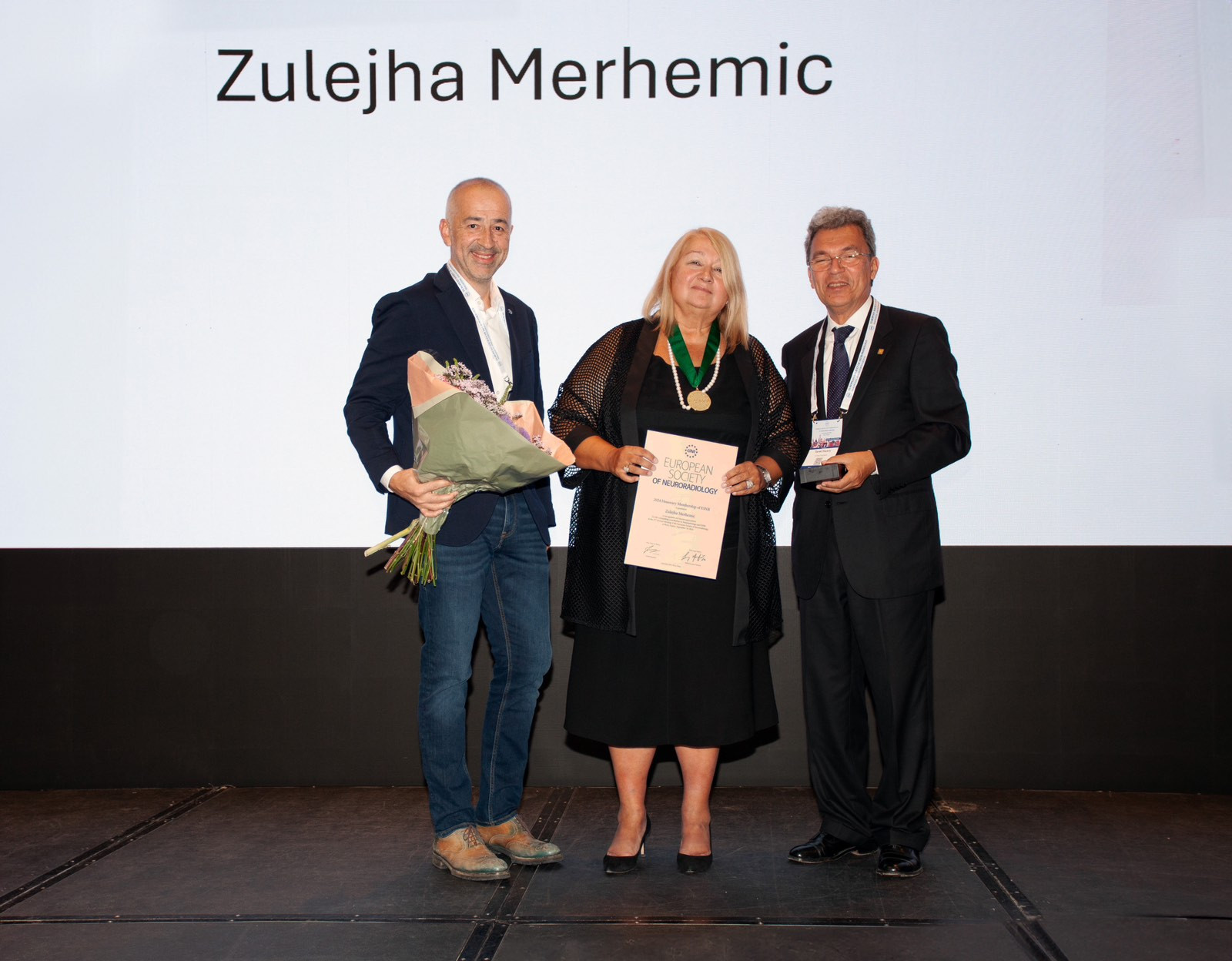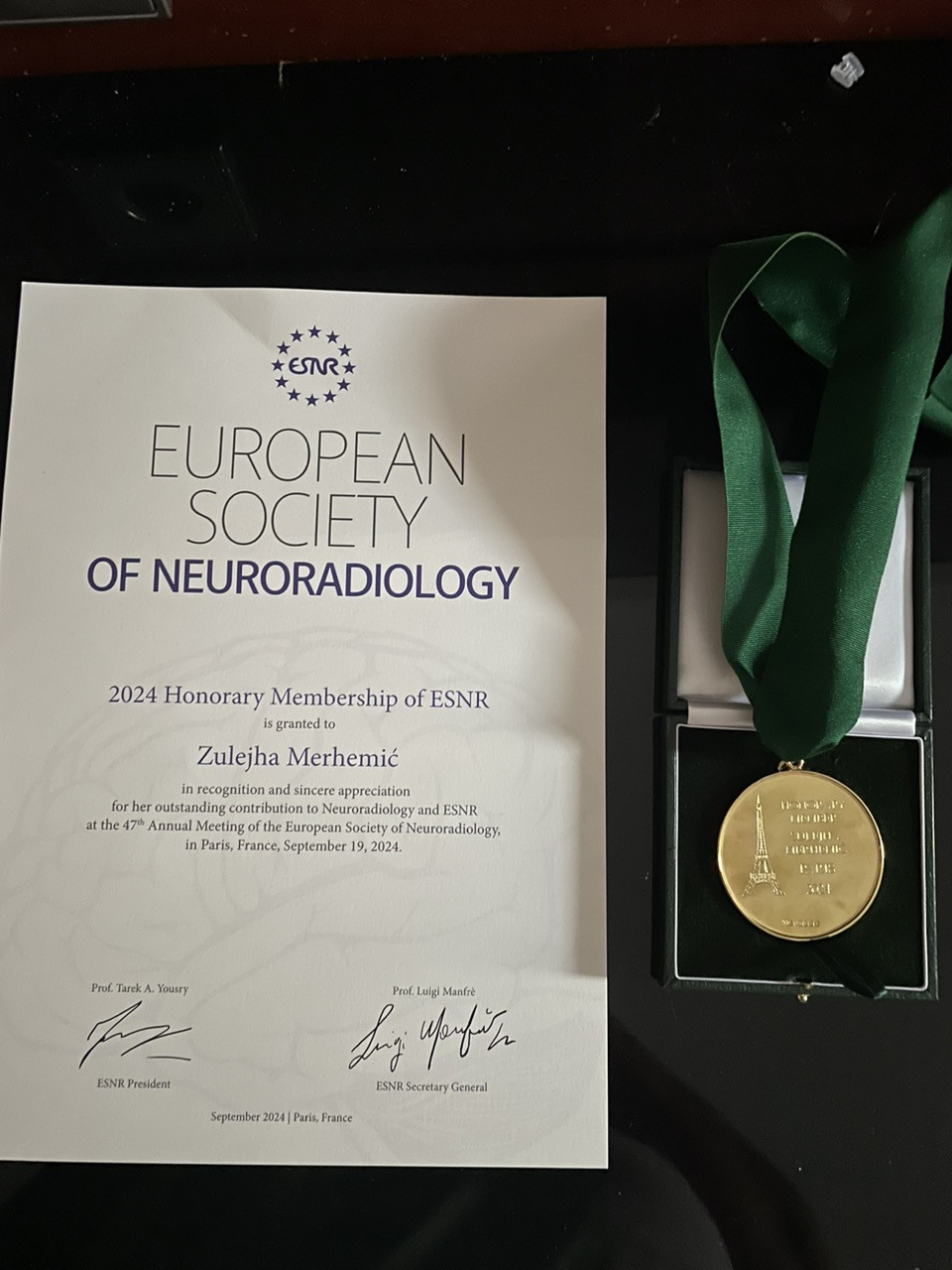
Radiology diagnostics specialist, Dr.sc. Zulejha Merhemić, a long-time member of BHAAAS, has been honored as a Fellow of the European Society of Neuroradiology. Dr. Merhemić, the first person from Bosnia and Herzegovina (BiH) to achieve this prestigious level of membership, has been actively contributing to the development and promotion of the medical field for over 20 years. In addition to her work in BiH, she has made a significant impact as a visiting professor at foreign universities, sharing her extensive knowledge and experience with students and colleagues.
One day a week, she dedicates her time to volunteering at the General Hospital "Prim. Dr. Abdulah Nakaš" in Sarajevo, providing essential support and education. Her research interests include complex areas such as arteriovenous malformations, tumors, and aneurysms, placing her among the leading experts in the region.

Neuroradiology, a branch of radiology, uses sophisticated diagnostic methods to visualize diseases of the brain and spinal cord. In many countries, this field is considered a distinct specialty, while in others, it is part of a broader radiology discipline. Dr. Merhemić expertly employs various radiological methods, including CT and MRI, placing her at the forefront of innovative medical diagnostic approaches.
We spoke with Dr. Zulejha Merhemić about her motivations for volunteer work, challenges and achievements in the field of neuroradiology, and the importance of international collaboration and knowledge exchange in medical science.
1. Could you tell us how you decided on a career in neuroradiology and what attracted you to this specific field of medical science?
During the war, I lived in Austria, where I went through the process of having my Sarajevo Medical School degree recognized at the Medical University of Vienna. I spent a year working in the MRI Department, where I wrote all the reports, gathered materials, and wrote my dissertation. That was when I realized the immense potential MRI holds for brain and spine diagnostics, which attracted me and led to my decision to focus on neuroradiology. When I returned to Sarajevo, I dedicated myself entirely to neuroradiology. In 1998, the Sarajevo University Clinical Center received a 1.5 Tesla MRI machine, which enabled quality diagnostics and research. As a result, my work was soon accepted at international congresses, where I became a regular presenter. That’s how I found my place in neuroradiology. I became a member of the European Society of Neuroradiology in 2003.
2. As the first Bosnian and Herzegovinian to become a Fellow of the European Society of Neuroradiology, how does it feel to be recognized at such a high level, and how does it impact your profession?
When I received the notification that I would become a Fellow of the European Society of Neuroradiology, I was overjoyed because this is the highest recognition the society grants for contributions to neuroradiology.
3. Your research interests cover various aspects of the central nervous system, vascular anomalies, tumors, and aneurysms. Which of these areas do you find most interesting or challenging, and why?
Given my advanced age, I have been volunteering for more than three years at the General Hospital in Sarajevo, and in addition, I write reports for several private radiology clinics. I remain actively engaged in science and education. I am a member of the Educational Board of Neuroradiology (EBNR), where I teach courses and have been an examiner for the European Diploma in Neuroradiology subspecialization for 14 years. My fields of interest include vascular changes in the brain (aneurysms, AVMs, AVFs) and the spinal cord, different types of brain and spinal tumors, congenital anomalies, and infections. Everything in neuroradiology is significant for patients, so I can't highlight one area as more important than the others.

4. As a visiting professor at foreign universities, how do you perceive the differences in the approach to neuroradiology between BiH and the countries where you teach?
In Bosnia and Herzegovina, there are only a few MRI machines, all of which are fully occupied for diagnostic purposes, limiting their use for scientific research, unlike in wealthier European countries where new sequences are developed and machines of 7 Tesla or more are used for research purposes. However, the diagnostic volume we handle allows us to see many patients and interesting cases, which is advantageous for scientific work. Even though we don’t have the most modern technology, my paper on spinal canal tumors was included in the required reading at Johns Hopkins University in the United States for subspecialist education.
5. Your work at the General Hospital "Prim. Dr. Abdulah Nakaš" also includes volunteering. How do you manage to balance your research, academic work, and volunteering, and what motivates you to contribute to the community?
It's true that I am very busy, but I feel immense happiness because my patients and colleagues benefit from my knowledge and experience. Throughout it all, my family provides me with significant support and understands the importance of my community involvement. My motivation comes from the desire to improve healthcare and education, and I believe my work makes a real difference in the lives of those around me.
6. How does your membership in the Bosnian-Herzegovinian American Academy of Arts and Sciences (BHAAAS) influence your work and research, and what role does this organization play in promoting and advancing knowledge and expertise among Bosnians and Herzegovinians both in the diaspora and at home?
Being a member of BHAAAS enables me to engage in a rich exchange of knowledge and experience between experts in neuroradiology, neurosurgery, and neurology from the region and the United States. We all work in different ways but share the same goal of improving health through innovative scientific approaches. This type of collaboration is crucial for advancing knowledge and expertise in Bosnia and Herzegovina, as it provides access to the latest research and technologies and supports professional development both in the country and within the diaspora.